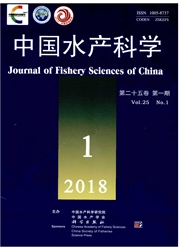

 中文摘要:
中文摘要:
为研究线粒体ATP酶F1-δ基因在鲢(Hypophthalmichthys molitrix)中的作用,采用RACE-PCR技术克隆出该基因全长,应用半定量 RT-PCR 法检测该基因在不同组织的表达,应用实时荧光定量 PCR 法检测急性低氧胁迫过程中不同溶氧浓度下该基因的组织表达变化。结果显示,鲢线粒体ATP酶F1-δ基因全长762 bp,开放阅读框480 bp,编码159个氨基酸残基,5′端非编码区114 bp,3′端非编码区168 bp。鲢与斑马鱼(Danio rerio)线粒体F1-δ编码氨基酸序列的相似性最高,达到89%;与大西洋鲑(Salmo salar)、罗非鱼(Oreochromis niloticus)、樱花钩吻鲑(Oncorhynchus masou formosanus)鲀、红鳍东方(Takifugu rubripes)的相似性分别为76%、75%、74%、69%;半定量RT-PCR结果显示,该基因在鲢心脏、脑、肝、脾和肌肉中均有表达,且心脏中最高,肌肉次之;实时荧光定量PCR结果表明,水中溶解氧(DO)分别为5.6(对照组)、4.38、3.37、2.11、1.12和0.54 mg/L时,随着溶解氧浓度的下降该基因在心脏中的表达逐渐下降且均显著低于对照组(<0.05);而在脑、肝、脾和肌肉中的表达则先升高后降低。寡霉素抑制法测得低氧胁迫过程中,鲢心脏等组织中 F1F0-ATP 酶活性均先升高后降低。这表明鲢线粒体 ATP 酶F1-δ基因在低氧胁迫中起到一定的作用,并对ATP酶的合成产生影响。
 英文摘要:
英文摘要:
We evaluated the effect of hypoxia on the mitochondrial ATPase F1-δ subunit gene in silver carp (Hy-pophthalmichthys molitrix). The full-length cDNA of this gene was cloned by rapid amplification of cDNA ends (RACE) PCR, and the expression of this gene was detected in different tissues by semi-quantitative RT-PCR. We then measured the relative expression of this gene in the different tissues following exposure to acute hypoxia stress of 5.6 mg/L (con-trol), 4.38 mg/L, 3.37 mg/L, 2.11 mg/L, 1.12 mg/L, or 0.54 mg/L dissolved oxygen [DO] using quantitative real-time PCR. The full-length cDNA of the mitochondrial ATPase F1-δ subunit gene was 762 bp, containing an open frame reading of 480 bp encoding 159 amino acids, and a 114 bp 5′-untranslated region and 168 bp 3′-untranslated region. The deduced amino acid sequence of the mitochondrial ATPase F1-δsubunit gene exhibited high similarity with Dario rerio (89%) and moderate similarity with Salmo salar(76%), Oreochromis niloticus(75%), Oncorhynchus masou formosa-nus(74%), and Takifugu rubripes(69%). Expression of the gene was highest in the heart followed by the muscle, with low levels of expression in the brain, liver, and spleen in silver carp. Expression of this gene decreased gradually as dissolved oxygen levels decreased. Expression in the heart was significantly lower (〈0.05) in the hypoxia-exposed fish than in the control group. Conversely, levels were initially significantly higher (〈0.05) in the brain, liver, spleen, and muscle of hypoxia-exposed fish, before decreasing significantly (〈0.05). F1F0-ATPase activity first increased then decreased in all the tissues during acute hypoxia stress. Changes in expression of the F1-δsubunit gene were consistent with changes in ATP enzyme activity in the brain, liver, spleen, and muscle, but not in the heart. The initial increase in expression ofδmay be caused by positive self-regulation of the gene in response to changes in desolved oxygen(DO). However, if d
 同期刊论文项目
同期刊论文项目
 同项目期刊论文
同项目期刊论文
 期刊信息
期刊信息
